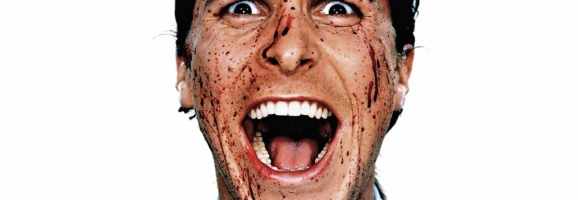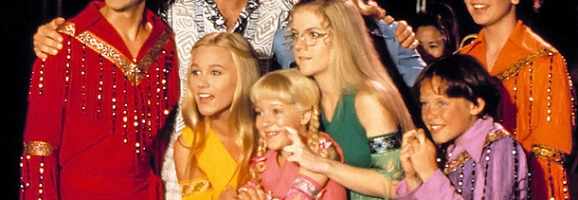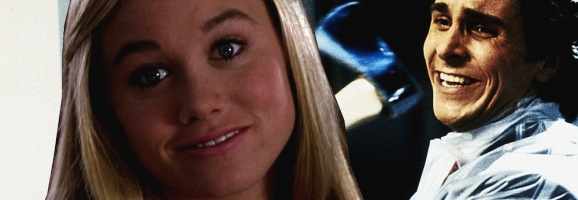America’s Culture of Greed: Patrick Bateman Versus the Brady Bunch

I had the odd and possibly disturbing pleasure of watching The Brady Bunch Movie (1995) and American Psycho (2000) back to back the other night. While the former is a PG-13 spoof on the classic, innocuous 1970s sitcom of the same name, and the latter based on a wholly transgressive and gut-wrenchingly horrifying novel by satirist Bret Easton Ellis, the two films share a common thematic goal.
A short introduction: The Brady Bunch Movie takes the titular family from the television show and places them anachronistically in 1990s California. The humor stems from how oblivious they are to the world around them, which has changed dramatically since the show originally aired (to clarify, the world hasn’t changed nearly as much as the media’s portrayal of it has). The film centers around an evil neighbor, Larry Dittmeyer, a ridiculously selfish real estate developer, who needs the Brady’s to sell their iconic home in order to turn the area into a shopping mall.
The Bradys must then raise $20,000 to pay back taxes or the house will be auctioned to Dittmeyer. In good old Brady fashion, the kids group together and eventually win a musical “Search for the Stars” contest, performing for an auditorium of bored looking grunge teens and, who would’ve guessed, the Monkees.

American Psycho is a different beast, a story about young, attractive, investment banker Patrick Bateman, extreme materialist and narcissist, unreliable narrator, and possibly serial killer and his misadventures in a late ’80s wealthy Manhattan social circle. The film, like the novel, revolves around Bateman’s shallow obsession with appearances, extreme adoration for popular music, dinner reservations, and a series of increasingly gruesome murders, his own distorted American Dream.
On its surface, the film is a satire of a society obsessed with capitalism. The film is “about” Bateman’s commodification of people, especially women, reducing them to meat reserved for sex and violence, and his lifestyle of soulless material gain and superficiality that ultimately leaves him in a constant state of dissatisfaction and pain.
American Psycho, suave, transgressive, and completely sexual (without being erotic), is a highly “postmodern” work, one that covers itself in layers of truths, signs, and realities. It’s sort of obviously postmodern, and the novel is an essential postmodern text. The Brady Bunch Movie is harder to pin down.

It’s mostly an homage to the simplicity of ’70s America and its media, poking a good amount of fun at it while still being lovingly nostalgic about it. The film is an over-the-top “spoof” of ’70s American pop culture, but it is also very much a critique of contemporary American culture, that is, America in the late 1980s and 1990s.
California has been overrun by punks and thugs, and although the film never truly gets at the grittiness of reality (which would have made it a better, funnier film), cars are jacked by thieves, sex is rampant, and several establishing shots of downtown Los Angeles reveal heavy traffic, homelessness, and an obsession with the then newish cellphones.
While not as graphic, this California is very much the same one that characters Clay and Trent mope through in Ellis’ first novel, Less Than Zero (1985), materialistic, overcrowded, and without goodness or soul, just tidied up for a PG-13 comedy of manners. While free of its stylized transgressive qualities and explicit imagery, these two depictions of Los Angeles are not very different.
The tagline for The Brady Bunch Movie is “They’re Back To Save American From The ’90s,” and this notion of “saving” America is an important piece to the film’s overall thesis.
The Bradys are weird and everyone in the film knows it. From neighbors claiming they’ve “never seen a toilet” in the Brady house to the absurdity of the children’s relationships with schoolmates, the Bradys represent an extremely naive worldview, closed off from the horrors of the newsworthy world, but through this naivety comes something honest and possibly wholesome.
At the end of the film, when the Bradys buy their home back, it is their tenacious love for each other and for their community, however goofy and blind, that succeeds and is the moral backbone of the film.
The Bradys are outdated, yes, and their cultural blindness may seem immoral and certainly humorous, but they do in fact “save America” from the truly evil capitalist, real estate developer Larry Dittmeyer. The culture clash that the film revolves around is aware that both stereotypical 1970s and 1990s media depictions of reality are absurd, but it goes to great lengths to say that both can be morally sound and that goodness can actually come from the wholesome and blind if there is a sense of truth and goodness.
Patrick Bateman from American Psycho is also “saving America,” but in a vastly different way. His ironic tale warns against the dangers of 1980s capitalism, a Reagan safe era, and above all, the superficial and materialistic American and his media. Instead of showing that love prevails over material gain, Bateman exemplifies what happens when love and essence cannot overcome material greed and superficiality.
Unconsciously, The Brady Movie is the optimistic (and possibly naive) answer to the question than American Psycho poses: has all of American culture’s soul been drained by greed and superficiality, been worn out by the pressures of a vicious capitalism? American Psycho, which is a thesis-heavy piece, seems to argue that yes, America is drained and worn. The Brady Bunch Movie, which is a mere collection of sitcom and comedy film tropes more than it is an essay, does not explicitly say much of anything, but it does hint at the notion of American goodness still lingering in the streets of (post)modern America.

It would be decidedly humorous and poignant to see the two narratives cross paths, with Patrick Bateman maybe trying to murder and eat Marcia Brady, only to be caught and given a stern look by Mr. and Mrs. Brady, or maybe Alice stumbles into the room and makes an obvious joke while holding a basket of laundry. The Bradys exude a charm that repels the vulgar and narcissistic actions of Patrick Bateman, and in the spoof film, are his antithesis.
In the Brady world, the world of the film, the rules of the narrative are that nothing bad can truly happen, which is the opposite of Bateman’s world, with his unreliable narration a display of everything bad can and will happen.
Interestingly, both the Bradys and Patrick Bateman are very extreme stylized versions of an American identity, the naive do-gooders and the hostile capitalist, only the naivety and hostility are turned up to eleven. These American caricatures are both critiques at their most severe.
Two equal and opposite sides of the same argument are found in these wildly different films. There’s a certain charm in comparing and contrasting the two films, an absurd uncertainty, but the parallel fits. Both American Psycho and The Brady Bunch Movie revolve around the same concept.
What do you think? Leave a comment.











Honestly I wasn’t a big fan of the American Psycho film adaptation. The charm of the book was making the reader feel emptier and emptier the more they read. If we could just make the film somewhat episodic the way the book was but only show murders at random intervals I think we could succeed of capturing the spirit of the book.
I think in the book, you see Bateman in an entirely other light.. All those scenes where he tortures woman in the most horrible ways and even though they scream and cry or puke or wets themselves he doesn’t reflect at all what they are feeling; they are like objects. And these scenes are no joke – IMO there was nothing funny about them, no funny dialogue or wisecracking. Even the more bizarre torture he did wasn’t amusing. Rather I felt cold reading all those chapters.
In the movie, all the murders where done rather comically, in one way or another. Christian Bale as Patrick Bateman was great but he was too much a clown. The absolute deadliness and craziness and unreasoness Patrick had in some particular chapters in the book was missing, and I’m not sure if it can be adapted to film easily or at all.
I agree that the book and film are different experiences, but the way the film deals with the murders does not diminish their poignancy.
Though I’d be curious to see a closer adaptation to the novel, but only with a puke bag handy ; )
Well, you know you are getting too old when you can remember when the Brady Bunch show originally first aired and these plot lines (all rolled into one ninety minute film) are more stupid than they were at first. Anyway the cast was much better in the original, did not like the tribute movie at all.
Wow, you didn’t like it?
I’ve been a fan of Bret Easton Ellis for a long time. There’s been some nice adaptations of his work. My top list of his work:
1. The Rules of Attraction – at this time in my life (senior year in high school) after witnessing all my friend’s fragile romances, I can relate to it the most.
2. Lunar Park – very well written, certain scenes kept me on edge (the movie on his computer, as someone already said), and just interesting to see how he views himself, even if it’s part fiction.
3. American Psycho – well written, relevent plot, funny, disturbing, this is what introduced me to his work (maybe the same for a lot of other people too).
4. Less Than Zero – good but not his best, more a social comentary than a character driven epic, interesting to see where he grew from as a writer.
I haven’t seen the film version of the Rules of Attraction, but I like the book a great deal. Read it after graduating college ; )
I’d recommend Glamorama, it is very underrated. Although it is somewhat irritating at first, it improves drastically after the first third. And works on many different levels.
Lunar Park, I feel, started off very strongly, then ran out of gas and became bogged down in the “Steven King thing” Based on the introductory chapter, it could have been so much more. I wish it had carried on in that vein.
I had heard that about Lunar Park. I feel like none of his books get at the level of brilliance that American Psycho did, even though I like some of them a great deal.
i have read all of BEEs’ books except American Psycho. i started it, but couldnt finish as it was quite disturbing and due back at the library, hahah.
my list is:
1. Less Than Zero (the first one of his books i read, and the best, in my opinion)
2. Glamorama (very interesting, couldnt put it down)
3. Lunar Park (same as Glamorama, i couldnt stop reading it)
4. The Rules of Attraction (was ok, not his best)
5. The Informers (i found this book very disturbing and quite disgusting and at times i wasnt sure if i would be able to continue on. i read it last of all his books and knew he always included graphic images of murder and sex but this book went a bit too far for my liking, i found it to be too sensationalist, i didnt like it at all!!)
Imperial Bedrooms – worth looking up, but I can’t recommend it. It’s a sequel to Less than Zero, if you can imagine that, but it feels worn out and old, though there’s some strong writing.
I haven’t actually seen either of these films (and they do seem like a very odd match), but I can definitely agree with your suggestion that they both offer extreme and stylised versions of stereotypical American identities. Caricatures are used a lot in American pop-culture, especially in suburban settings like The Brady Bunch.
Fantastic comparison. I remember enjoying “The Brady Bunch Movie” upon its initial release, but I haven’t seen it since then. Perhaps it warrants a fresh look.
Well, this was certainly an interesting article! I am fascinated at the author’s choice to use two such wildly disparate movies as a way to illustrate the extremes of human nature and characteristics, This was very well done and I enjoyed reading it. I look forward to reading more work by this author.
Interesting–unexpected, if, somewhat random comparison/contrast. The thematic tie between the films highlighted, “America’s Culture of Greed,” is one way of thinking of the relation. As I continued to read the analysis I sensed you were perhaps most interested in the absurdism of American life–the idea of combining elements of the two otherwise very distant movies being a nice possible avenue to that aesthetic goal. For me, David Lynch is the king of the “absurdist American aesthetic.” His art is certainly “postmodern” in all relevant senses of that chewed up notion, but what I like about it–and here bringing Brady Bunch and American Psycho together makes Lynchian sense–is his juxtaposition of the ordinary, everyday realism of American cultural forms with monstrous characters and dark, existentially significant experiences.
Absolutely spot-on, especially the bit “absurdist American aesthetic.” If they ever did a Brady Psycho mash-up, I bet David Lynch (or one of his biggest fans) wouldn’t be far behind.
This is quite an accurate comparison it seems that the Brady’s are very much like all of Bateman’s friends and colleagues throughout American Psycho. Both are quite oblivious to what is going on around them.
“Ignorance is bliss” seems to be the right path for some. As we can see, the Brady’s are clearly much happier than Bateman, but at what cost?
This brings up many philosophical questions that I would love to continue discussing.
Wow, I literally just watched The Brady Bunch Movie a few days ago, and now I come across your article! And I thought that I was the only one who had seen that movie!
Now, having not read or seen American Psycho, my comments can’t be that penetrating, but I do want to compliment you on one line in particular: “the world hasn’t changed nearly as much as the media’s portrayal of it has”. Indeed, as good as shows from that era are, they are VERY odd in tone, when looked at from a modern perspective. Think of when The Brady Bunch was on the air: The late 60s-early 70s, the era of race riots, assassinations and social unrest. Yet the Brady’s chose to focus on…getting one’s nose hit by a football. I’m not trying to hate on the show (I like sitcoms from all eras), but it seems, in a way, missing something.
Modern television shows are, without question, much more realistic, much darker, and, yes, much better. But I don’t want us to, because of this, begin to perceive the entire world as dark and evil just because shows like Breaking Bad are popular. This is just as bad as seeing the 60s/50s/whatever decade as a bizarre fantasy land devoid of social problems. Just as the world isn’t all like the way it is in The Brady Bunch, it also isn’t all terrible, the way Breaking Bad appears to us. Both shows are representations meant to invoke certain feelings and get us to think about as aspect of the world we live in. There is always more to the world than the media shows us.
It is in many ways the embodiment of the 70s (despite being made in the 60s), along with Three’s Company.